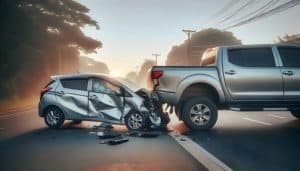Have you recently been involved in a vehicle collision? Car accidents can range from minor fender-benders to catastrophic rollovers, and the type of collision often dictates the severity of injuries. Understanding how to claim injuries based on the type of collision is crucial for ensuring that you receive the compensation you deserve. Whether you’re involved in a rear-end collision, a T-bone accident, or a rollover, knowing the specifics of each type can make the claims process smoother and more successful.

What Is Rear-End to Rollover?
Rear-end to rollover refers to the spectrum of car accidents, ranging from the most common and typically less severe rear-end collisions to the more serious and potentially life-threatening rollover accidents. If you’ve been injured in a car accident in Los Angeles, understanding this spectrum is crucial, as each type of collision presents unique challenges and considerations when it comes to claiming injuries.
- Rear-End Collisions: These happen when a vehicle crashes into the back of another. They are the most common type of accident and often result in whiplash or minor injuries. However, in some cases, more severe injuries like concussions or back injuries can occur.
- Side-Impact Collisions (T-Bone): These occur when one vehicle’s side is struck by the front or rear of another vehicle. The resulting injuries can vary widely, depending on the speed and angle of the collision.
- Head-On Collisions: This type of accident is often the most dangerous, occurring when the front ends of two vehicles collide. The force of the impact can lead to severe injuries, including fractures, internal injuries, and spinal cord damage.
- Rollover Accidents: These are less common but can be the most devastating. A vehicle rollover can cause multiple injuries, from broken bones to life-threatening conditions like traumatic brain injury (TBI) or spinal cord injuries.
Step-Guide on Claiming Injuries Based on Rear-End to Rollover
It’s important for motorists to know the step guide on claiming injuries based on rear-end to rollover accidents because each type of collision can result in different types of injuries, legal implications, and compensation challenges.
1. Document the Accident Scene
Immediately after the accident, if you are physically able, take photos of the scene. Capture the vehicles’ positions, as well as any visible injuries and damages. This visual evidence can be crucial for proving the type and severity of the collision.
2. Seek Immediate Medical Attention
Regardless of the collision type, it’s essential to get medical help as soon as possible. Even if you feel fine, injuries like whiplash, internal injuries, and concussions may not show symptoms immediately. A medical report will also serve as vital evidence in your claim.
3. Report the Accident to Authorities
Filing a police report is necessary to document the accident officially. The report will include the officer’s assessment of the accident, which is useful in determining fault and supporting your injury claim.
4. Consult with a Personal Injury Lawyer
Different types of collisions might require different legal approaches. A personal injury attorney who is experienced in car accident cases guides you through the claims process, ensuring that your rights are protected and that you pursue the correct compensation for your injuries.
When choosing a lawyer, it’s crucial to consider their experience, particularly with car accident cases like yours. Look for someone who has a good track record in handling claims involving the specific type of collision you’ve experienced, whether it’s a rear-end or rollover accident.

5. File an Insurance Claim
Notify your insurance company about the accident as soon as possible. You must provide them with all the necessary documentation, including the police report, medical records, and any evidence you gathered. Be honest and detailed in your account, as this will help in processing your claim.
6. Understand the Value of Your Claim
The type of collision significantly impacts the value of your injury claim. Rear-end collisions might result in lower settlements due to typically less severe injuries. In contrast, rollovers or head-on collisions can justify higher compensation due to the potentially severe and long-lasting impacts on your health.
7. Negotiate and Settle
Your lawyer will help negotiate with the insurance company. Be prepared for counteroffers and the possibility of legal proceedings if a fair settlement cannot be reached. Your aim should be to secure compensation that adequately covers medical expenses, lost wages, and pain and suffering.
Conclusion
Navigating an injury claim after a car accident can be complex, varying by collision type. To increase your chances of fair compensation, it’s essential to document the accident, seek medical attention, and work with a personal injury lawyer. Each type of collision presents unique challenges, but with the right approach, you can protect your rights and support your recovery.






